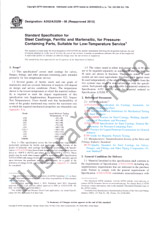Potřebujeme váš souhlas k využití jednotlivých dat, aby se vám mimo jiné mohly ukazovat informace týkající se vašich zájmů. Souhlas udělíte kliknutím na tlačítko „OK“.
ASTM D5278/D5278M-09(2017)
Standard Test Method for Elongation of Narrow Elastic Fabrics (Static-Load Testing)
Přeložit název
NORMA vydána dne 15.7.2017
Informace o normě:
Označení normy: ASTM D5278/D5278M-09(2017)
Datum vydání normy: 15.7.2017
Kód zboží: NS-692663
Počet stran: 3
Přibližná hmotnost: 9 g (0.02 liber)
Země: Americká technická norma
Kategorie: Technické normy ASTM
Kategorie - podobné normy:
Anotace textu normy ASTM D5278/D5278M-09(2017) :
Keywords:
elastic fabric, elongation, static load,, ICS Number Code 59.080.30 (Textile fabrics)
Doplňující informace
| Significance and Use | ||||||||||||||
|
5.1 This test method is considered satisfactory for acceptance testing of commercial shipments of narrow elastic fabrics because the test method is used in the trade for acceptance testing. 5.1.1 In case of a dispute arising from differences in reported test results when using this test method for acceptance testing of commercial shipments, the parties should conduct comparative tests to determine if there is a statistical bias between their laboratories. Competent statistical assistance is recommended for the investigation of bias. As a minimum, the two parties should take a group of test specimens that are as homogeneous as possible and that are from a lot of material of the type in question. The test specimens should then be randomly assigned in equal numbers to each laboratory for testing. The average results from the two laboratories should be compared using student's 5.2 This test method specifies the use of a static load apparatus. Users of this test method are cautioned that elongation test data obtained using this test method are not comparable to elongation test data obtained using either constant-rate-of-extension (CRE) or constant-rate-of-loading (CRL) type tensile testing machines. |
||||||||||||||
| 1. Scope | ||||||||||||||
|
1.1 This test method determines the elongation characteristics of narrow elastic fabrics made from natural or man-made elastomers, either alone or in combination with other textile fibers, when tested with a static load testing procedure before or after laundering. Note 1: For determination of similar characteristics using the
constant-rate-of-extension (CRE) type tensile testing machine,
refer to Test Method D4964.
Note 2: For determination of similar characteristics using the
constant-rate-of load (CRL) type tensile testing machine, refer to
Test Method D1775.
1.2 The use of this test method requires the selection of, or mutual agreement upon, the effective static load at which the test results will be determined. 1.3 Laundering procedures used will be those specified in Test Method AATCC 135 for 3 washing and drying cycles. 1.4 The values stated in either SI units or inch-pound units are to be regarded separately as standard. The values stated in each system may not be exact equivalents; therefore, each system shall be used independently of the other. Combining values from the two systems may result in non-conformance with the standard. 1.5 This standard does not purport to address all of the safety concerns, if any, associated with its use. It is the responsibility of the user of this standard to establish appropriate safety, health and environmental practices and determine the applicability of regulatory limitations prior to use. 1.6 This international standard was developed in accordance with internationally recognized principles on standardization established in the Decision on Principles for the Development of International Standards, Guides and Recommendations issued by the World Trade Organization Technical Barriers to Trade (TBT) Committee. |
||||||||||||||
| 2. Referenced Documents | ||||||||||||||
|




 Cookies
Cookies
